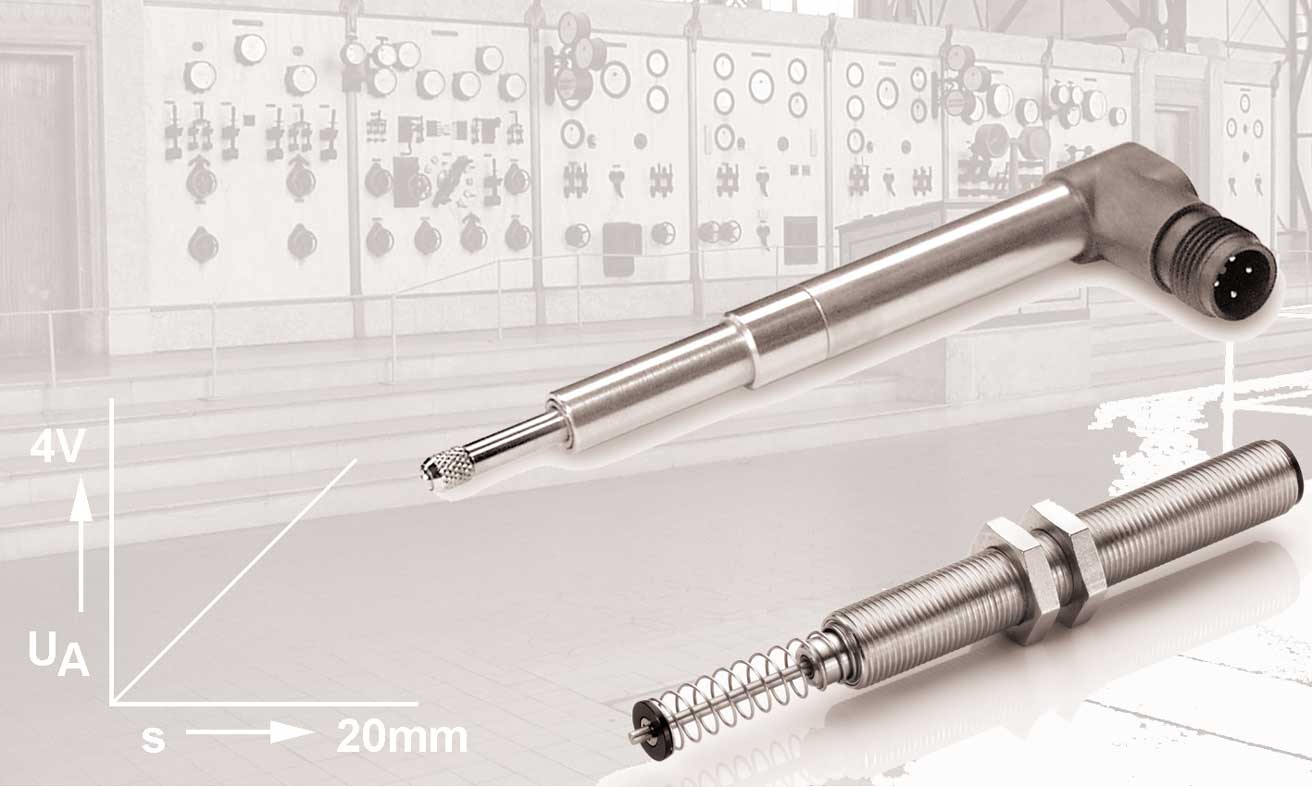Analogue sensors for versatile position and angle measurement
- Details
- Hits: 10129
In recent years, the need for sensors to record geometric variables has increased significantly in all areas of industrial applications. The optimal solution for every need requires a customized sensor that can be selected according to the criteria of measuring range, resolution, accuracy, design and environmental conditions. AB Jödden has suitable ones for all applications analog sensors – from inductive to capacitive, in miniature and Atex versions.

Contents
- Structure and function of inductive displacement transducers
- Inductive miniature displacement sensors with integrated electronics
- With Atex approval for the Ex area
- Tilt, acceleration and vibration sensors
Structure and function of inductive displacement transducers
 The typical version An inductive displacement transducer consists of a hollow coil body with strictly symmetrically wound coils, a magnetic shield with high permeability and the round stainless steel housing. The spaces between the coil and the housing are completely filled with hardening Plastic shed.
The typical version An inductive displacement transducer consists of a hollow coil body with strictly symmetrically wound coils, a magnetic shield with high permeability and the round stainless steel housing. The spaces between the coil and the housing are completely filled with hardening Plastic shed.
The plunger moves through the bobbin Nickel-iron alloy and changes the inductance of the two coil halves in opposite directions. The bore of the bobbin and the diameter of the plunger are selected so that contactless, wear-free movement can take place.
The contactless measurement is a major advantage of inductive displacement transducers and therefore enables them to be used, among other things, in machines for material testing and on vibration test tables. Due to the infinite resolution, the smallest path changes of the plunger can be measured, which are only caused by the noise of the connected Electronics are limited. The almost unlimited service life and high reliability enable use in sensitive applications such as satellite technology, aircraft or Industrial automation.
The freely movable one pestle has no stop and can be pulled out of the transducer. If overstrokes occur, the displacement transducer is not destroyed. Only axial movements of the plunger lead to a change in inductance. Radial movements in the measuring direction are not recorded, so that lever movements, for example, can be measured.
Inductive sensors in power plants
 To Recording of positions Inductive displacement transducers are used in high-pressure steam bypass valves and water injection valves on steam turbines in power plants. There is a requirement to accurately record the valve position between 0 and 100% (corresponds to 4 to 20 mA output signal). In order to compensate for the mechanical tolerances of the valves, the start and end values of the position transducers must be adjustable. The installation and adjustment of the position transducers should be simple and reliable.
To Recording of positions Inductive displacement transducers are used in high-pressure steam bypass valves and water injection valves on steam turbines in power plants. There is a requirement to accurately record the valve position between 0 and 100% (corresponds to 4 to 20 mA output signal). In order to compensate for the mechanical tolerances of the valves, the start and end values of the position transducers must be adjustable. The installation and adjustment of the position transducers should be simple and reliable.
The programmable inductive displacement transducers meet these requirements integrated electronicsk. The analog measured value of the inductive displacement transducer is digitized with a 16-bit A/D converter and processed in a microcontroller. The measurement values are corrected using the accuracy deviations stored in an Eeprom. The digital information is converted into standardized output signals 16 (0) to 4 mA or 20 to 0 (5) V using a 10 bit D/A converter. The user can program the measuring path required for the application.
The transducer will be set to the desired one starting point and a contact will be made on Plug- Or Cablesoutput connected to the operating voltage for at least 2 s. This sets the output signal to the initial value. The final value is set in the same way.
The successful Coding is signaled by a brief change of the output signal to the middle position. This technology allows different measuring paths to be represented with just one position transducer: A position transducer with a nominal 150 mm measuring path corresponding to 0 to 10VDC Output signal can have measuring paths from a minimum of 0 to 26 mm to a maximum of 0 to 160 mm in a 0 to 10 VDC Implement voltage signal.
The permissible operating voltage range between 9 and 32 VDC, the high accuracy of 0,1% and the various output signals enable use in many areas. Additional mechanical attachments such as ball joints on the plunger and housing, protective tubes or button versions with return springs are available. The electrical connection can be made either via Plug or waterproof cast Cables. In this version, protection class IP68 (submersion) is achieved.
Inductive miniature displacement sensors with integrated electronics
 The inductive displacement sensors SM27 series have a diameter of 10 mm and record measuring distances of up to 20 mm. An integrated microcontroller evaluates the change in inductance caused by the axial displacement of a NiFe metal core.
The inductive displacement sensors SM27 series have a diameter of 10 mm and record measuring distances of up to 20 mm. An integrated microcontroller evaluates the change in inductance caused by the axial displacement of a NiFe metal core.
The Operating voltages of 5 or 24 VDC and the low operating current of only typ. 3 mA enable the use also in mobile systems. The off-proportional, analog output signal from 0 to 4 VDC can be processed directly by many evaluation units. In addition, digital interfaces such as the RS232 or PWM signals are possible.
Also these miniature sensors in Degree of protection IP68 withstand extreme environmental conditions such as oil mist, mud, rain and dust and withstand shock loads of up to 250 g SRS and vibration loads of up to 20 g rms.
With Atex approval for the Ex area
The inductive displacement transducers of the series SM20 and SM26 are installed and cast in a flameproof housing. This structure has protection class IP68, is approved for use in hazardous areas and is marked II 2 GD T 80°C EEx d IIC T6. The displacement transducers are supplied with the required carrier frequency and the signal processing can be carried out using standard electronic modules from the SM12 series. Intrinsically safe circuits are not required due to the encapsulation of the position transducer.
The measuring paths up to 4 mm are measured with an accuracy of <0,25%, in the connected electronic modules, in 0 (4) to 20 mA, 0 to 10 V.DC or ± 10 VDC reshaped.
Tilt, acceleration and vibration sensors

The capacitive measuring sensors are highly accurate (Resolution up to 0,0004° or 15 µg) and mechanically very resilient. The sensors are based on a further developed 'bulk micromachined' MEMS technology. The three-dimensional structure (3D-MEMS) of these sensors contains a pendulum made of single-crystalline silicon. This is hermetically enclosed between two silicon plates. This results in a long-term stable, high-resolution and shock-resistant sensor. Gas damping in the measuring element prevents overshooting and disruptive resonance vibrations. The pendulum movement is measured capacitively with an ASIC.
The measuring elements are in small, sturdy metalcasing assembled and cast. The sensors require an output signal of 0,5 to 4,5 VDC an operating voltage of 5 VDC or 7 to 35 VDC and can be used in ambient temperatures between -40° and +100°C.
 Distance sensor with fast time-of-flight measurement method
Distance sensor with fast time-of-flight measurement method
typical Application examples For these sensors are tilt applications such as tilt limit sensors, leveling of machines, apparatus and measuring devices, automatic leveling of booms, excavator buckets, platforms. When measuring inclination and angles, they are used in inclination sensors for measuring devices (laser distance measuring devices), vehicles, railway carriages, operating tables, construction and production machines.
For accelerationmeasurements The sensors are used for impact monitoring on railway wagons, for shock and crash monitoring, motion detection for fitness analysis or in senior citizen alarm systems, free fall detection and in automotive applications such as ESP and ABS systems. Vibration measurements are possible for early bearing damage detection, anti-theft protection or earthquake safety shutdown, to name just a few

Bernd Jödden is the managing partner of AB Jödden GmbH in Krefeld.
